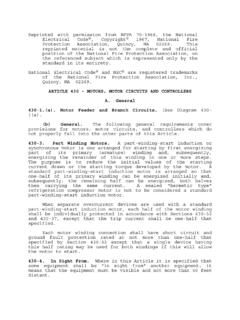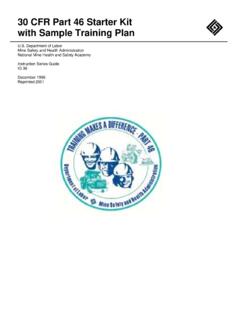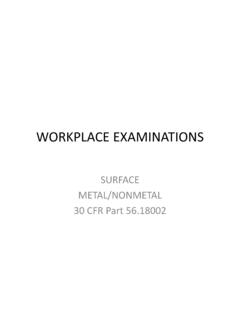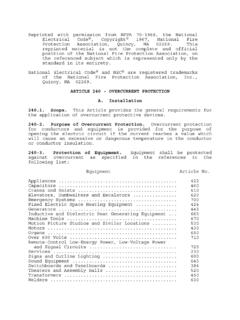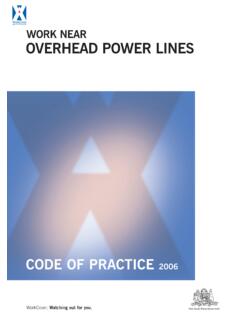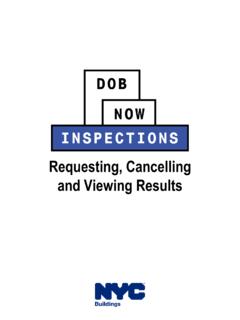Transcription of INSPECTING AND REPLACING WIRE ROPES
1 MODULE NUMBER 14 OFINSTRUCTION GUIDE NUMBER 43ON-THE-JOB TRAININGFORSURFACE METAL AND NONMETAL MINESINSPECTING AND REPLACING WIRE ROPESThis module describes basic job steps, potential hazards and accidents, and recommendedsafe job procedures for INSPECTING and REPLACING wire ROPES . The term "wire rope" is used inthis module, ratherthan "cable," to avoid any possible confusion with electrical cables. Thismodule is not intended to cover wire ROPES that are used for hoisting the sand, gravel, and crushed stone industry, wire ROPES are used primarily on draglines,power shovels, and drillng equipment. Wire ROPES and wire rope slings are used on cranesand hoists of various ROPES deteriorate and will break if left in service long enough.
2 Causes of ropedeterioration may include wear, peening (hammer action), corrosion, bending, flexing, kinking,crushing, overloading, and heat must provide for wire rope inspection and timely replacement. The purpose ofthe inspection program should be to obtain all possible service from wire ROPES whilemaintaining an adequate degree of safety. Wire rope replacement is costly, but if a wire ropebreaks in service, there are risks of serious injury, equipment damage, and lengthy rope breakage can pose hazards to equipment operators and persons working can be injured by fallng equipment and material, or by the whipping (backlash) actionof the broken rope failures can be fatal, although disabling injuries are more common.
3 Two examplesof fatal accidents follow:A dragline operator at a sand and gravel operation was killed when the pendant ropeof the dragline broke and backlashed through the cab cement plant worker was killed when the boom hoist rope of a mobile crane broke,dropping the crane boom on ofthe hazard of wire rope breakage can be eliminated by following a few simple safetyrules:1. Always assume a wire rope could break at Do not work or pass under the buckets or booms of shovels, draglines, or cranesin Stay clear of suspended Do not ride on or in dippers, clamshells, hoisted loads, hoisting hooks, buckets, orsimilar hoisting items, unless special provisions for hoisting personnel, inaccordance with safety rules and regulations, are if the above precautions are observed, safety also depends on proper wire ropemaintenance and inspection procedures, and the timely removal from service of worn ordamaged wire mining regulations contain few requirements relating directly to inspection andreplacement of wire ROPES that are not used to hoist persons.
4 Some general federalrequirements, however, do apply to such wire rope. Self propelled equipment, which is to beused during a shift, must be inspected by the equipment operator before being placed inoperation. Equipment defects affecting safety must be corrected before the equipment isused. Unsafe machinery and equipment must be removed from service information and guidance on wire rope inspection and replacement can beobtained from:1. American National Standard for Wire Rope for Mines, ANSI M , and other ANSIS tandards relating to specific types of Occupational Safety and Health Administration (OSHA) Standards for GeneralIndustry (29 CFR 1910) and Construction Industry (29 CFR 1926).
5 3. State Wire rope and equipment manufacturer's Safety rules of various associations and various company should have a wire rope inspection program which establishes inspectionpersonnel, procedures, and frequency; and provides for reporting and record keeping. Aneffective inspection program should establish two general types of inspections:1. Frequent inspections - visual wire rope inspections conducted by equipmentoperators before, during, and after equipment use, in conjunction with routineinspection of other equipment Periodic inspections - careful and detailed wire rope inspections, includingdiameter measurements, conducted by a person who has extensive knowledge,training, and experience in the inspection of wire ROPES and related procedures used, and the inspection frequency for each wire rope, will varydepending on operating conditions, anticipated rope life, and critical nature addition to INSPECTING wire rope itself, wire rope inspections should also include ropeterminations (end attachments)
6 At both ends ofthe particular rope and items contacted by therope, including sheaves, drums, and Rope BasicsThe following summary provides equipment operators with basic information useful forfrequent inspections of wire rope. Persons responsible for making periodic, detailedinspections should have a much more comprehensive knowledge of wire Rope UseSome common uses of wire rope include:1. Hoist and boom suspension (pendant) ROPES on power shovels, draglines,clamshells, and mobile Crowd, retract, and dipper trip ROPES on power Boom hoist ROPES on draglines, clamshells, and mobile Drag (rehaul) ROPES on Holding, closing, and tag ROPES on Pull down, hoist, bull, and sand line ROPES on Hoist ROPES on overhead hoists, and overhead traveling Rope Construction and TerminologyMost wire rope is constructed of many small diameter wires.
7 This construction provides theflexibiliy necessary for wire rope to bend frequently in use, such as over , large strands, or ROPES constructed of a few wires of large diameter, will be usedfor applications where very little bending occurs, such as boom suspension (pendant) ropeson shovels, or wire ROPES consist of three parts:1. A core, which forms the center of the rope. Cores may be either fiber cores (FC),or steel cores. Steel cores may be either "independent wire rope cores" (IWRC) -a miniature wire rope which serves as a core for larger rope, or "strand cores" (SC)- a strand, similar to other strands of the rope, which runs down the center of Wires, which are twisted into strands.
8 The individual wires that appear on theoutside of the rope, and bear against sheaves and drums, are called crown wires,or simply "outer wires."3. Strands, which are twisted around the core to form the rope is designated by the number of strands, the number of wires per strand, and therope diameter. For example, a wire that has 6 strands of 19 wires each is referred to ashaving a 6x19 "construction." Wire ROPES of similar construction are sometimes grouped intoa general "classification." The 6x19 classification usually includes 6x21 and 6x25 constructionropes, as well as 6x19 construction diameter is measured by rotating a caliper around the circumference of a wire rope untilthe caliper is positioned to give the maximum possible reading.
9 The length of rope neededfor one strand to make a complete turn around the core is a "lay."Safety Factor/Design FactorThe rated breaking strength of a new rope divided by the maximum normal load to be placedon the rope is the "safety factor," or "design factor".Safety Factor = Breaking StrengthMax Normal LoadA rope with a 100,000 pound breaking strength, carrying a maximum normal load of 10,000pounds, has a safety factor of 100,000/10,000= minimum safety factors for various wire rope applications are specified in the ANSI standards. In most cases, "load" is determined by the weight of the structure and the materialsupported. In some cases, however, such as for drag ROPES on draglines, the load is basedon the maximum stall force of the power lubrication extends the service life of wire ROPES .
10 Proper lubrication:1. Reduces wear2. Protects against corrosion3. Reduces friction between individual wires and strands, allowing wires and strandsto move and to adjust to load and bending forces. This ease of movementincreases the flexibiliy of the rope, allowing more even distribution ofthe load overall the wires, which reduces the probability of wire ROPES need ample lubrication to ease the break-in period. The rope manufacturer shouldbe consulted to be sure that proper types of lubricant and application methods are , the more severe the rope operation - higher speeds, heavier loads, greater numberof bends, and more corrosive conditions - the more frequently the rope should be , frequent lubrication is generally better than heavy, occasional following safe job procedures will help to minimize incidents which could cause injuriesand adversely affect or recommended personal protective equipment:Hard hat, safety shoes, safety glasses, gloves,Safety harness and OFBASIC JOB STEPS1.





